Astronomy fanatica
-
Goldstone Deep Space Communications Complex
The Goldstone Deep Space Communications Complex (GDSCC) — commonly called the Goldstone Observatory — is located in California's Mojave Desert (USA). Operated by the Jet Propulsion Laboratory, its main purpose is to track and communicate with space missions. The observatory is part of NASA's Deep Space Network.
Goldstone radio telescopes are also used in the search for ultra-high energy neutrino interactions in the Moon by using large-aperture radio antennas. (See link.)
Goldstone Deep Space Communications Complex, California, USA
General Information
Organization: NASA, JPL, Caltech
Location: Mojave Desert (near Barstow), San Bernardino County, California, USA
Wavelength regime: radio
Webpage
Physical Characteristics
Telescope Style: reflector
Diameter: 34 m
Collecting Area: ~910 m2
Mounting: Alt/Az
Dome: none
70 m antenna
Issue #106 -
Astronomy Picture of the Day
2005 June 8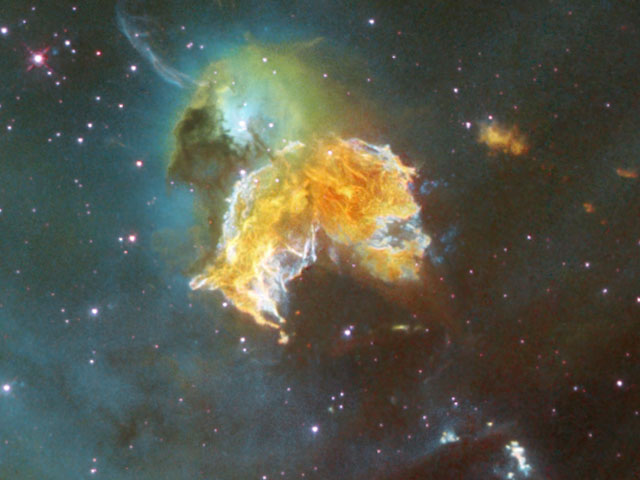
Rampaging Supernova Remnant N63A
Explanation: What has this supernova left behind? As little as 2,000 years ago, light from a massive stellar explosion in the Large Magellanic Clouds (LMC) first reached planet Earth. The LMC is a close galactic neighbor of our Milky Way Galaxy and the rampaging explosion front is now seen moving out - destroying or displacing ambient gas clouds while leaving behind relatively dense knots of gas and dust. What remains is one of the largest supernova remnants in the LMC: N63A. Many of the surviving dense knots have been themselves compressed and may further contract to form new stars. Some of the resulting stars may then explode in a supernova, continuing the cycle. Pictured above is a close-up of one of the largest remaining knots of dust and gas in N63A taken by the orbiting Hubble Space Telescope. N63A spans over 25 light years and lies about 150,000 light years away toward the southern constellation of Dorado.
Credit: NASA, ESA, HEIC, and The Hubble Heritage Team (STScI/AURA);
Acknowledgment: Y.-H. Chu & R. M. Williams (UIUC) -
Jodrell Bank Observatory
The Jodrell Bank Observatory (originally the Jodrell Bank Experimental Station, then the Nuffield Radio Astronomy Laboratories from 1966-1999) is located near Congleton, Cheshire in the north west of England. The observatory is part of the University of Manchester and has played an important role in the research of quasars and pulsars. In 1979, scientists of Jodrell Bank announced the first detection of a gravitational lens; which confirmed one of Einstein's theories.
The 76m Lovell Telescope at Jodrell Bank Observatory.
The observatory was established in 1945 by Dr. Bernard Lovell, who wanted to investigate cosmic rays after his work on radar in World War II. One of the telescopes of the observatory honours his name.
General information
The first radio telescope was built in 1947, but the famous "Mark I" telescope, at the time the largest steerable dish radio telescope in the world, 76.2 m (250 ft) in diameter, was constructed in the mid 1950s, becoming operational in the summer of 1957, just in time for the launch of Sputnik 1, the world's first artificial satellite. Jodrell Bank was the only installation in the world able to track Sputnik's booster rocket by radar, and the fame and income this brought in enabled the considerable construction debts to be paid off.
In February 1966, Jodrell Bank tracked the USSR unmanned moon lander Luna 9 and listened in on its facsimile transmission of photographs from the moon's surface. The photos were sent to the British press and published before the Soviets themselves had made the photos public.
The Mark I telescope has been updated twice, to allow greater sensitivity and make structural repairs. At the time of its construction in 1957, it was the world's largest fully steerable radio telescope and was only expected to have an operational lifespan of 10 years. It was therefore upgraded in 1970-71 and 2001-2003. In 1987, on its 30th anniversary, the telescope was renamed The Lovell Telescope in Sir Bernard's honour. A second radio telescope, the Mark II, was built at Jodrell Bank in 1964, with a diameter of approximately 25 metres (it's parabolic, not circular), while a third telescope, the Mark III, located some 20 miles away near Nantwich is part of the Jodrell Bank Observatory. Other radio telescopes are also located at the Jodrell Bank Observatory - one which is 42 ft (13 m) in diameter, and a 7 m one which is generally used for undergraduate teaching purposes for students of the University. Webcams of these are available for viewing on the Jodrell Bank webpage.
Jodrell Bank Observatory is also the base of the Multi-Element Radio Linked Interferometer Network (MERLIN), a National Facility run by the University of Manchester on behalf of PPARC.
Visitor facilities
The much-visited site was planted as an arboretum by Sir Bernard. Jodrell Bank Arboretum houses the UK's national collections of Malus and Sorbus species and the Heather Society's Calluna collection, on 35 acres (140,000 m²). The arboretum also features a small scale model of the solar system, the scale being approximately 1:5,000,000,000. In 2005, as part of the SpacedOut project, Jodrell Bank became the location of the Sun in a 1:15,000,000 scale model of the solar system covering the UK.
There is an educational visitors' centre at the site. In 2003 the old science centre was demolished to make way for a new one, expected to open in approximately 2007. In the interim, visitor facilities are very limited. However, visitors have access to a new path wrapping around the telescope, approximately 20 m from the telescope's outer railway.
Statistics of the Lovell Telescope
Location:
- Latitude 53 deg 14 min 13.2 s north
- Longitude 2 deg 18 min 25.74 s west
Mass of telescope: 3200 t
Mass of bowl: 1500 t
Diameter of bowl: 76.2 m
Surface area of bowl: 5270 m²
Collecting area of bowl: 4560 m²
Height of elevation axis: 50.5 m
Maximum height above ground: 89.0 m
Radius of wheel girders: 38.5 m
Outer diameter of railway track: 107.5 m
Amount of paint for 3 coats of the bowl: 5200 L
Issue #107 -
Astronomy Picture of the Day
2005 June 9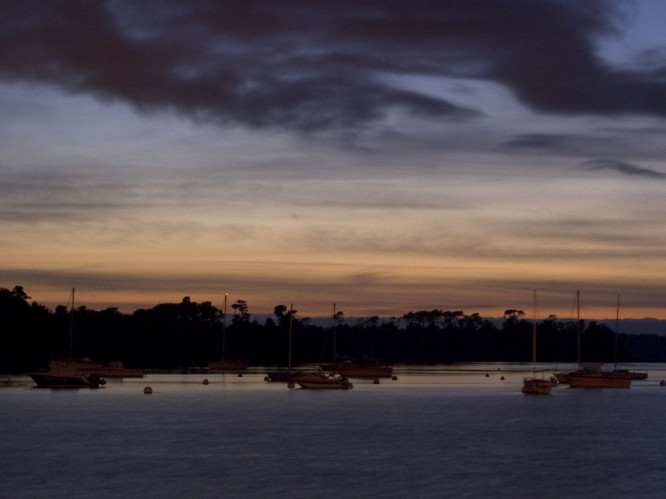
Venus Returns to the Evening Sky
Explanation: This serene image of boats moored in the harbor of l'ÃŽle-Tudy, Bretagne, France was taken on June 1st, about an hour after sunset. It also features Venus, third brightest celestial object after the Sun and Moon. For casual skygazers, this month marks Venus' return to the evening sky as the brilliant 'star', shining low in the west-northwest shortly after sunset. In the picture, astrophotographer and APOD translator Laurent Laveder notes that Venus is easily mistaken for a light atop a sailboat's tall mast, giving the otherwise stunning celestial beacon an unremarkable appearance. Of course, a year ago Venus' appearance was quite remarkable. On June 8, 2004, Venus crossed the Sun's disk, the first transit of Venus since 1882. Late this week Venus shares the evening sky with the young crescent Moon, and will next transit the Sun on June 6, 2012.
Credit & Copyright: Laurent Laveder (Version française officielle de l'APOD) -
Kitt Peak National Observatory
The Kitt Peak National Observatory (KPNO) is located on a 2,096 m (6,880 ft) peak of the Quinlan Mountains in the Arizona-Sonoran Desert on the Tohono O'odham Nation, 55 miles southwest of Tucson. The observatory is considered to be part of the National Optical Astronomy Observatory (NOAO), although some of the telescopes located here, like those at the MDM Observatory, belong to other groups.
Landscape of telescopes at Kitt Peak National Observatory, Tohono O'Odham Nation, Arizona.
General Information
Organization: NOAO
Location: Tohono O'odham Nation, Arizona, United States
Coordinates: 31° 58' N, 111° 36' W
Altitude: 2,096 m (6,875 ft)
Webpage
Telescopes
Mayall Telescope: 4.0 m Ritchey-Chrétien reflector
WIYN Telescope: 3.5 m Ritchey-Chrétien reflector
McMath-Pierce Solar Telescope: unobstructed solar reflector
General information
Kitt Peak was selected in 1958 as the site for a national observatory under contract with the National Science Foundation (NSF) and was administered by the Association of Universities for Research in Astronomy. The land was leased from the Tohono O'odham under a perpetual agreement. In 1982 NOAO was formed to consolidate the management of three optical observatories — Kitt Peak, the National Solar Observatory facilities at Kitt Peak and Sacramento Peak, New Mexico, and the Cerro Tololo Inter-American Observatory in Chile.
The principal instruments at KPNO are the Mayall 4 metre telescope; the WIYN 3.5 metre telescope and further 2.1 m, 1.3 m, 0.9 m, and 0.4 m reflecting telescopes. The McMath-Pierce Solar Telescope located on the facilities is the largest solar telescope in the world, and the largest unobstructed reflector (it doesn't have a secondary mirror in the path of incoming light). The National Radio Astronomy Observatory 12 m radio telescope that was decommissioned in 2002 is also in the location.
Mayall Telescope (4.0 m) at Kitt Peak National Observatory
Kitt Peak is also famous for hosting the first telescope (an old 91 cm reflector) used to search for near-Earth asteroids, and calculating the probability of an impact with planet Earth.
McMath-Pierce Solar Telescope at Kitt Peak National Observatory
Issue #108 -
Astronomy Picture of the Day
2005 June 10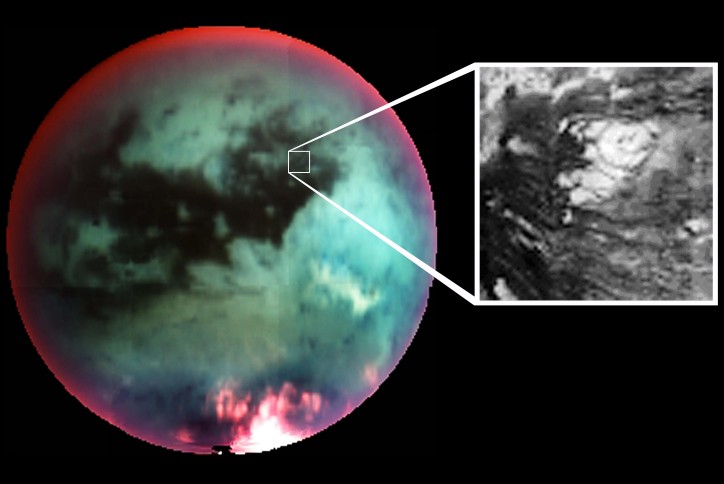
Titan's Cryovolcano
Explanation: Investigators suspect the domed feature detailed above is an ice volcano, or cryovolcano, seen in infrared light through the hazy atmosphere on Saturn's moon Titan. Since Titan's surface temperature is around -180 degrees Celsius, 'lava' welling up to form the volcanic mound would be icy indeed - possibly a slurry of methane, ammonia, and water ice combined with other ices and hydrocarbons. The circular feature is roughly thirty kilometers in diameter. If its volcanic nature is confirmed, the discovery of cryovolcanism on Titan could explain the origin of methane in Titan's atmosphere. Before the Cassini-Huygens mission to Saturn, a popular explanation for replenishing Titan's concentration of atmospheric methane was the presence of an extensive, methane-rich, hydrocarbon sea. But Cassini's instruments and the Huygens surface probe have failed to find such a global ocean.
Credit: VIMS Team, U. Arizona, ESA, NASA -
Nançay Radio Telescope
The Nançay Decimetric Radio Telescope (official abbreviation NRT) is located in the small town of Nançay, two hours' drive south of Paris, France. The radio telescope saw first light in 1965, after an inauguration by the then French president, Charles de Gaulle.
Nançay Radio Telescope primary mirror. Note the small person standing at the base.
The NRT is a transit instrument of the unusual Kraus-type design where the flat primary reflects radio light towards the spherical secondary, which focuses it towards a mobile focal carriage. The primary tilts North-South to select any object near the meridian, while the focal carriage moves East-West along railroad ties to track objects for roughly an hour within transit. The Kraus-type design, named after Dr. John D. Kraus (1910-2004), is also used at the Ohio State University Big Ear Telescope.
Nançay Radio Telescope focal carriage with the secondary in the background.
Issue #109 -
Astronomy Picture of the Day
2005 June 11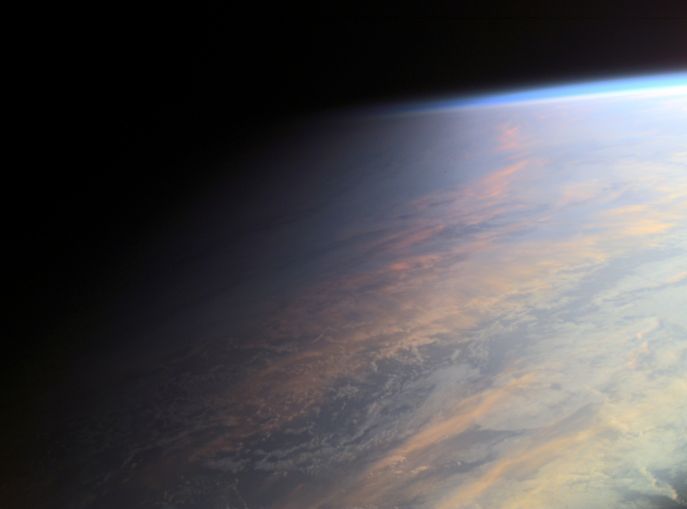
Earth at Twilight
Explanation: No sudden, sharp boundary marks the passage of day into night in this gorgeous view of ocean and clouds over our fair planet Earth. Instead, the shadow line or terminator is diffuse and shows the gradual transition to darkness we experience as twilight. With the Sun illuminating the scene from the right, the cloud tops reflect gently reddened sunlight filtered through the dusty troposphere, the lowest layer of the planet's nurturing atmosphere. A clear high altitude layer, visible along the dayside's upper edge, scatters blue sunlight and fades into the blackness of space. This picture actually is a single digital photograph taken in June of 2001 from the International Space Station orbiting at an altitude of 211 nautical miles.
Credit: ISS Crew, Earth Sciences and Image Analysis Lab, JSC, NASA -
National Radio Astronomy Observatory
The National Radio Astronomy Observatory (NRAO) is an institution set up by the United States government for the purpose of radio astronomy. NRAO designs, builds, and operates its own high-power radio telescopes for use by scientists around the world.
Locations
Charlottesville, Virginia
Headquarters. Located on the University of Virginia campus.
Green Bank, West Virginia
NRAO is the constructor/owner of the worlds largest fully mobile radio telescope, the Green Bank Telescope (GBT), which resides in Green Bank, West Virginia. Green Bank is also the home of NRAO's prinicipal observatory as it is the center of a United States national radio quiet zone, which NRAO is also responsible for maintaining. It resides on a 13,000 square mile piece of land void of electromagnetic pollution.
Green Bank Telescope (GBT)
The land was set aside by the FCC in 1958, as a Radio Quiet Zone; the area closest to the telescope is free of fixed radio transmitters, and all other fixed radio transmitters (TV and radio towers) inside the zone are required to transmit away from the telescope, often at limited power. It is hard to keep the site free of radio pollution. To aid with the limiting of outside interference, the surrounding area is planted with pines characterized by needles of a certain length as to 'block' electromagnetic interference at the wavelengths used by the observatory. At one point, the observatory faced the problem of North American flying squirrels tagged with US Fish & Wildlife Service telemetry transmitters. Also things like electric fences and other radio wave emitters have caused great trouble for the astronomers in Green Bank.
The observatory contains many other notable telescopes, including 3 85 foot telescopes forming an interferometer array, a 40 foot telescope used by school groups and organizations for small scale research, a fixed radio 'horn' built to observe Cygnus X-1, a bunk house to facilitate these guests, as well as a reproduction of the original Jansky antenna built by Karl Jansky while he worked for Bell Labs to detect the interference that was discovered to be previously unknown natural radio waves emitted by the universe.
Socorro, New Mexico
The NRAO's facility in Socorro is the Array Operations Center (AOC). Located on the New Mexico Tech campus, the AOC serves as the headquarters for the Very Large Array (VLA), which was the setting for the movie Contact, and the control center for the Very Long Baseline Array (VLBA). VLBA telescopes are located throughout the world.
Tucson, Arizona
Offices are located on the University of Arizona campus. Formerly operated the 12 meter telescope on Kitt Peak. That telescope has been shut down and funding rerouted to the Atacama Large Millimeter Array (ALMA) instead.
Santiago, Chile
The Atacama Large Millimeter Array (ALMA) site in Chile is at 5,000 m altitude near Cerro Chajnantor in northern Chile. This is about 40 km east of the historic village of San Pedro de Atacama, 130 km southeast of the mining town of Calama, and about 275 km ENE of the coastal port of Antofagasta.
Issue #110 -
Astronomy Picture of the Day
2005 June 12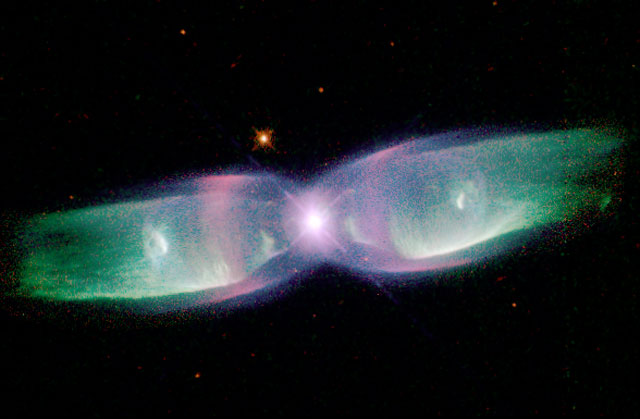
M2-9: Wings of a Butterfly Nebula
Explanation: Are stars better appreciated for their art after they die? Actually, stars usually create their most artistic displays as they die. In the case of low-mass stars like our Sun and M2-9 pictured above, the stars transform themselves from normal stars to white dwarfs by casting off their outer gaseous envelopes. The expended gas frequently forms an impressive display called a planetary nebula that fades gradually over thousand of years. M2-9, a butterfly planetary nebula 2,100 light-years away shown in representative colors, has wings that tell a strange but incomplete tale. In the center, two stars orbit inside a gaseous disk 10 times the orbit of Pluto. The expelled envelope of the dying star breaks out from the disk creating the bipolar appearance. Much remains unknown about the physical processes that cause planetary nebulae.
Credit: B. Balick (U. Washington) et al., WFPC2, HST, NASA -
Parkes Observatory
The Parkes Observatory is a radio telescope observatory, 20 kilometres north of the town of Parkes, New South Wales, Australia. It is best known as the dish which sent images of the first moon landing to the rest of the world.
The primary observing instrument is the 64-metre Parkes Radio Telescope, the largest movable dish in the Southern Hemisphere. It was completed in 1961 and has operated almost continuously to the present day. The dish surface was physically upgraded by adding smooth metal plates to the central part of the dish to provide focusing capability for centimetre and millimetre length microwaves. The outer part of the dish remains a fine metal mesh, creating its distinctive "two-tone" appearance.
The Parkes Observatory in New South Wales, Australia.
The collecting area of the Parkes radio telescope is a 64-m diameter paraboloid (the dish). The surface is high precision aluminium millimetre wavepanels to a diameter of 17-m (for operation to 43 GHz), then perforated aluminium plate out to 45-m, and rectangular galvanised steel 5/16-inch mesh for the remainder of the surface. The aerial cabin, which houses feeds and receiver equipment, is supported by a tripod.
The Parkes Observatory is situated near Alectown, 25 kilometres north of the town of Parkes which is approximately 365 kilometres west of Sydney. The Observatory is part of the Australia Telescope National Facility (ATNF) a division of the Commonwealth Scientific and Industrial Research Organisation (CSIRO). The Parkes site contains a 64-metre RadioTelescope, an administration building with offices, workshops and library, an Observer's Quarters and Visitors Centre.
The telescope has an altazimuth mount. It is guided by a small mock-telescope placed within the structure at the same rotational axes as the dish, but with an equatorial mount. The two are dynamically locked when tracking an astronomical object by a laser guiding system.
The receiving cabin is located at the focus of the parabolic dish, supported by three struts 27 metres above the dish. The cabin contains multiple radio and microwave detectors, which can be switched into the focus beam for different science observations.
The observatory is a part of the Australia Telescope National Facility network of radio telescopes. The 64 m dish is frequently operated together with the Australia Telescope Compact Array at Narrabri and a single dish at Mopra, to form a very long baseline interferometry array.
The dish
During the Apollo missions to the moon, the Parkes Observatory was used to relay communication and telemetry signals to NASA, providing coverage for when the moon was on the Australian side of the Earth (see link).
The observatory has remained involved in tracking numerous space missions up to the present day, including those of the Galileo and Cassini-Huygens probes. It is also a major world centre for research into pulsars, with more than half of those currently known today discovered at the Parkes Observatory.
The observatory and telescope were featured in the 2001 film The Dish, a fictionalised account of the observatory's involvement with the Apollo 11 moon landing.
Issue #111 -
Astronomy Picture of the Day
2005 June 13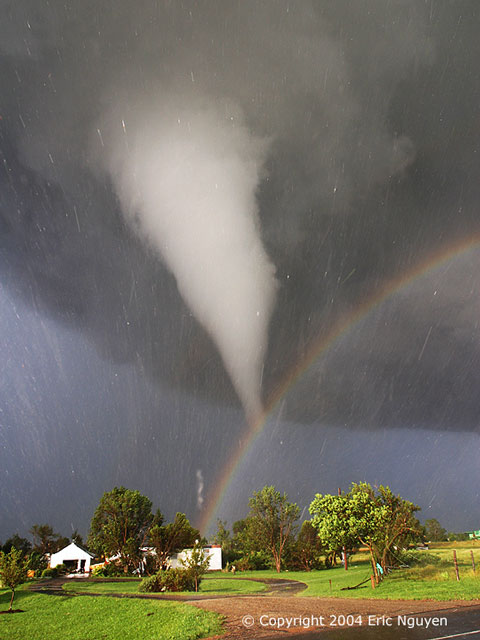
Tornado and Rainbow Over Kansas
Explanation: The scene might have been considered serene if it weren't for the tornado. Last June in Kansas, storm chaser Eric Nguyen photographed this budding twister in a different light -- the light of a rainbow. Pictured above, a white tornado cloud descends from a dark storm cloud. The Sun, peaking through a clear patch of sky to the left, illuminates some buildings in the foreground. Sunlight reflects off raindrops to form a rainbow. By coincidence, the tornado appears to end right over the rainbow. Streaks in the image are hail being swept about by the high swirling winds. Over 1,000 tornadoes, the most violent type of storm known, occur on Earth every year, many in tornado alley. If you see a tornado while driving, do not try to outrun it -- park your car safely, go to a storm cellar, or crouch under steps in a basement.
Credit & Copyright: Eric Nguyen (Oklahoma U.), www.mesoscale.ws -
Very Large Array
The Very Large Array (VLA) is a radio astronomy observatory located on the Plains of San Agustin, between the towns of Magdalena and Datil, some fifty miles (80 km) west of Socorro, New Mexico, USA. The VLA stands at an altitude of 6,970 ft (2,124 m) above sea level. It is a component part of the National Radio Astronomy Observatory (NRAO).
The NRAO's Very Large Array at Socorro, New Mexico, USA. Configuration "D".
Characteristics
The observatory consists of 27 independent radio antennae, each of which has a dish diameter of 25 meters and weighs 230 tons. The antennae are arrayed along the three arms of a Y-shape (each of which measures 21 km). Using the railroad tracks that follow each of these arms – and that, at one point, intersect with U.S. Highway 60 at a level crossing – and a specially designed lifting locomotive, the antennae can be physically relocated to a number of prepared positions, allowing aperture synthesis interferometry with a maximum baseline of 36 km: essentially, the array acts like a single antenna with that diameter. The highest angular resolution that can be reached is about 0.05 arcseconds.
Detail of one dish.
There are four commonly used configurations, designated A (the largest) through D (the tightest, when all the dishes are within 600 m of the center point). The observatory normally cycles through all the various possible configurations (including several hybrids) every 16 months: in other words, once the massive efforts needed to move two dozen 230-ton highly sensitive scientific instruments have been made, the antennae are not moved again for a period of three to four months.
The VLA site also currently serves as the control center for the Very Long Baseline Array (VLBA), a VLBI array of ten 25-meter dishes located from Hawaii in the west to the U.S. Virgin Islands in the east that constitutes the world's largest dedicated, full-time astronomical instrument.
Past and future
Congressional approval for the VLA project was given in August 1972, and construction began some six months later. The first antenna was put into place in September 1975 and the complex was formally inaugurated in 1980, after a total investment of USD $78.5 million.
With a view to upgrading the venerable 1970s technology with which the VLA was built, a proposal has been floated for the conversion of the VLA into the Expanded Very Large Array ("EVLA"). The upgrade would enhance the instrument's sensitivity, frequency range, and resolution, and would entail installing new hardware at the San Agustin site and the construction and installation of up to eight additional dishes in other parts of the state of New Mexico, up to 300 km away, connected to the hub via fiber-optic links.
Maintanance barn at the very large array. In the forground tracks for moving the dishes are visible. The dishes can be mounted at discrete positions and can only be moved at very calm wind conditons.
Popular culture
The VLA observatory featured prominently in Carl Sagan's 1985 novel Contact, albeit much expanded (131 dishes!) and renamed the "Argus Array". When the time came for Hollywood to make the motion picture version of the story (Contact, 1997), much outdoor footage was shot at the VLA site. The number of dishes visible on screen was artificially increased by means of Computer-generated imagery, however, and the canyon depicted as being in the vicinity of the VLA is actually Chelly Canyon in neighboring Arizona.
Visiting
The VLA site is open to visitors year round during daylight hours. A visitor center houses a museum and a gift shop, and a self-guided walking tour is available.
Issue #112 -
Astronomy Picture of the Day
2005 June 14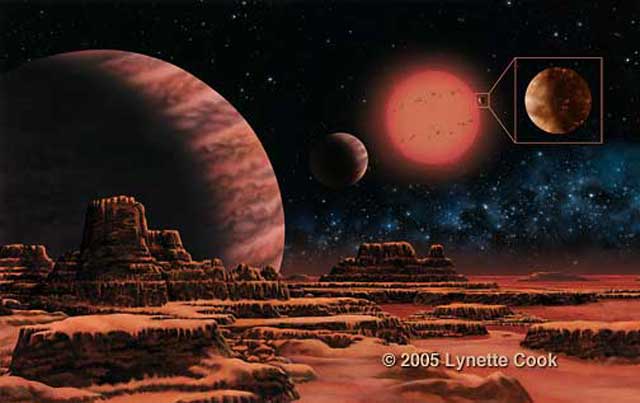
Gliese 876 System Includes Large Terrestrial Planet
Explanation: Is our Earth unique? In continuing efforts to answer this question, astronomers have now discovered an Earth-like planet orbiting a distant normal star. Previously over 150 gas-giant planets like Jupiter had been so discovered. Slight, fast, but regular wobbles of nearby small M-dwarf star Gliese 876 showed evidence for a planet with a likely mass slightly higher than a minimum six times the mass of Earth. The planet's small mass indicates that it is likely terrestrial in nature, similar in composition to the inner planets of our Solar System. If indeed made predominantly of rock, the planet's surface gravity would not even be able to contain the gasses of a Jupiter-like planet. The newly discovered planet would not make a good vacation spot for humans, however, as it orbits so close that the surface temperature probably tops a searing 200 degrees Celsius. The system is illustrated in the above drawing as seen from a hypothetical moon orbiting one of the two Jupiter-like planets already known. The newly discovered terrestrial-like planet is depicted in the insert. Gliese 876 lies only 15 light-years away and is visible with binoculars toward the constellation of Aquarius.
Illustration Credit & Copyright: Lynette Cook (spaceart.org);
Discovery Credit: E. Rivera (NASA's ARC) et al., HIRES, Keck Obs., NASA, NSF -
Very Long Baseline Array
The Very Long Baseline Array (VLBA) is a system of ten radio telescopes controlled remotely from the Array Operations Center in Socorro, New Mexico (USA). The array works together as the world's largest dedicated, full-time astronomical instrument. Its construction began in February of 1986, and was completed in May of 1993. The first observation using all ten sites occurred in May 29, 1993. The total construction cost was US$85 million.
Very Long Baseline Array (VLBA) locations.
Each VLBA station consists of an 82 foot (25 metre) diameter dish antenna and an adjacent control building which houses the station computer, tape recorders and other equipment associated with collecting the radio signals gathered by the antenna. Each antenna weighs 240 tonnes and is nearly as tall as a ten story building when pointed straight up. Altogether the array spans 5,000 miles.
The VLBA radio telescopes are located as follows:
- Mauna Kea, Hawaii
- Owens Valley, California
- Kitt Peak, Arizona
- Pie Town, New Mexico
- Los Alamos, New Mexico
- Fort Davis, Texas
- Brewster, Washington
- North Liberty, Iowa
- Hancock, New Hampshire
- St. Croix, United States Virgin Islands
Issue #113 -
Astronomy Picture of the Day
2005 June 15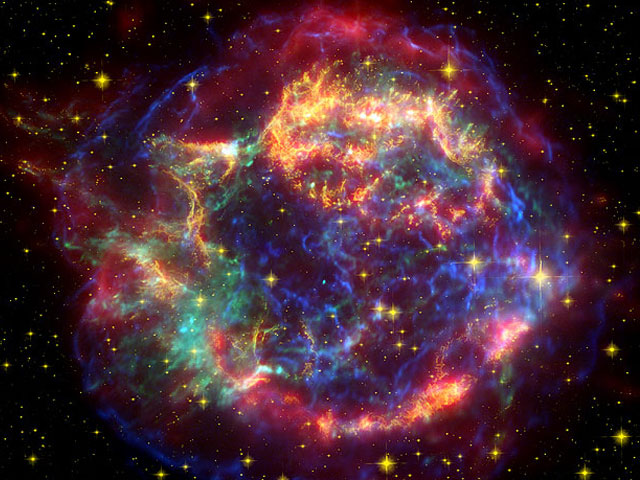
Cassiopeia A Light Echoes in Infrared
Explanation: Why is the image of Cassiopeia A changing? Two images of the nearby supernova remnant taken a year apart in infrared light appear to show outward motions at tremendous speeds. This was unexpected since the supernova that created the picturesque nebula was seen 325 years ago. The reason is likely light echoes. Light from the supernova heated up distant ambient dust that is just beginning to show its glow. As time goes by, more distant dust lights up, giving the appearance of outward motion. The above image is a composite of X-ray, optical, and infrared light exposures that have been digitally combined. The infrared light image was taken by the orbiting Spitzer Space Telescope and was used in the discovery of the light echo. Cassiopeia A spans about 125 light years and lies 10,000 light years away toward the constellation of Cassiopeia.
Credit: O. Krause (Steward Obs.) et al., SSC, JPL, Caltech, NASA -
Zond 3
Zond 3, a member of the Soviet Zond program, was the first Zond spacecraft to successfully complete its mission (a Lunar flyby) and took a number of amazing photographs for its time, though it is believed that it was initially intended to fly by Mars with Zond 2 but missed its window.
The spacecraft, a Mars 3MV-4A, was launched from a Tyazheliy Sputnik (65-056B) earth orbiting platform towards the Moon and interplanetary space. The spacecraft was equipped with an f106 mm camera and TV system that provided automatic inflight film processing. On July 20 lunar flyby occurred approximately 33 hours after launch at a closest approach of 9,200 km. 25 pictures of very good quality were taken of the lunar farside from distances of 11,570 to 9,960 km over a period of 68 minutes. The photos covered 19,000,000 km² of the lunar surface. Photo transmissions by facsimile were returned to Earth from a distance of 2,200,000 km and were retransmitted from a distance of 31,500,000 km (some signals still being transmitted from the distance of the orbit of Mars), thus proving the ability of the communications system. After the - lunar flyby, Zond 3 continued space exploration in a heliocentric orbit.
Mars 3MV-4A
The spacecraft design was similar to Zond 2, in addition to the imaging equipment it carried a magnetometer, ultraviolet (0.25 to 0.35 micrometre and 0.19 to 0.27 micrometre) and infrared (3 to 4 micrometre) spectrographs, radiation sensors (gas-discharge and scintillation counters), a radiotelescope and a micrometeoroid instrument. It also had an experimental ion engine.
It is believed that Zond 3 was initially designed as a companion spacecraft to Zond 2 to be launched to Mars during the 1964 launch window. The opportunity to launch was missed, and the spacecraft was launched on a Mars trajectory, although Mars was no longer attainable, as a spacecraft test.
- Launch Date/Time: 1965-07-18 at 14:38:00 UTC
- On-orbit dry mass: 960 kg
Issue #114 -
Astronomy Picture of the Day
2005 June 16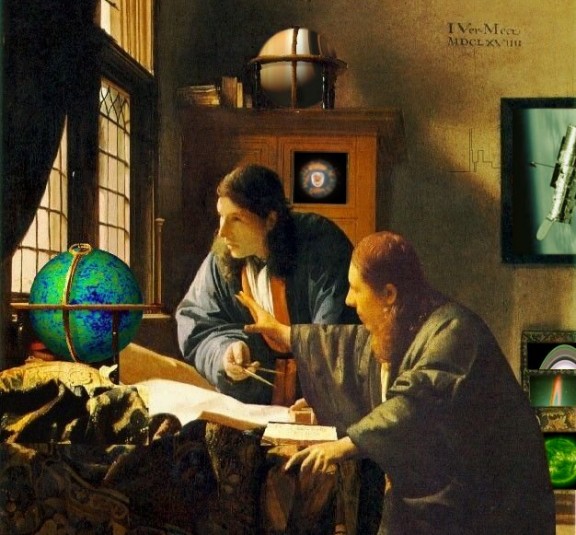
APOD Is Ten Years Old Today
Explanation: Welcome to the eleventh year of Astronomy Picture of the Day! In a decade of editing the APOD web pages, the industrious Robert Nemiroff (left) and persistent Jerry Bonnell (right) have enjoyed exploring compelling images of the cosmos that are not limited to those taken from earth orbit, much less to those taken by professional astronomers. In fact, seen in this recently released Vermeer, the editors are extremely grateful for the continued large volume of gracious e-mail and APOD submissions. Today, they would like to offer a sincere thank you to all. And while these APOD editors are definitely not getting any younger, tomorrow's picture may actually be ...
Apologies to: Vermeer's Astronomer and Geographer
Image Composite: Richard Taillet (Univ. de Savoie, LAPTH, LPNHE) -
Cheomseongdae astronomical observatory
Cheomseongdae astronomical observatory is an astronomical observatory which was built circa 647 in Silla, one of the Three Kingdoms of Korea. It was constructed under the rule of Queen Seondeok near Gyeongju, the capital of the kingdom.
Cheomseongdae Astronomical Observatory in Gyeongju, South Korea
Cheomseongdae means "star gazing tower". The observatory is built out of 362 pieces of cut granite which represent the 362 days of the lunar year. As can be seen from the photograph, it has 27 circular layers of stones (Queen Seondeok was the 27th ruler of the Silla Dynasty) surmounted by a square structure. 12 of the layers are below the window level and 12 are above. There are 12 large base stones set in a square, with three stones on each side. These sets of 12 may symbolize the months of the year.
The tower is 5.7 meters wide at the base and 9.4 meters tall, and filled with dirt up to the level of the window. Its construction style parallels that used at the Bunhwangsa Temple in Gyeongju and was likely a product of contact with the Tang Dynasty of China, with which Queen Seondeok allied her country.
Cheomseongdae is the oldest surviving observatory in its geographic region. It has been designated by the South Korean government as the country's 31st national treasure since December 20th, 1968.
Issue #115 -
Astronomy Picture of the Day
2005 June 17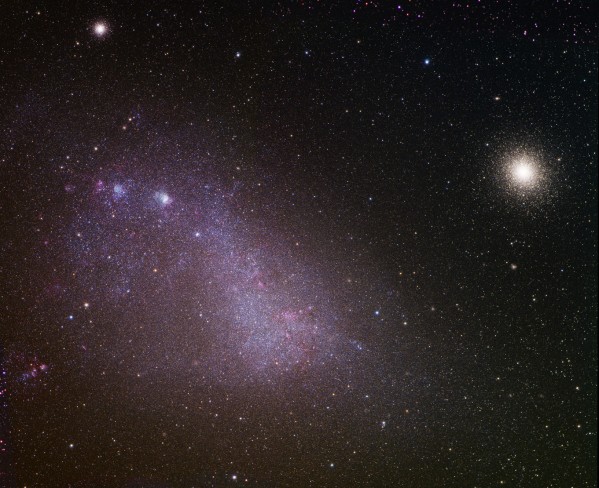
The Small Cloud of Magellan
Explanation: Portuguese navigator Ferdinand Magellan and his crew had plenty of time to study the southern sky during the first circumnavigation of planet Earth. As a result, two celestial wonders easily visible for southern hemisphere skygazers are known as the Clouds of Magellan. These cosmic clouds are now understood to be dwarf irregular galaxies, satellites of our larger spiral Milky Way Galaxy. The Small Magellanic Cloud pictured above actually spans 15,000 light-years or so and contains several hundred million stars. About 210,000 light-years distant in the constellation Tucana, it is the forth closest of the Milky Way's known satellite galaxies, after the Canis Major and Sagittarius Dwarf galaxies and the Large Magellanic Cloud. This gorgeous view also includes two foreground globular, star clusters NGC 362 (top left) and 47 Tucanae. Spectacular 47 Tucanae is a mere 13,000 light-years away and seen here to the right of the Small Magellanic Cloud.
Credit & Copyright: Josch Hambsch, Robert Gendler -
Dominion Astrophysical Observatory
Dominion Astrophysical Observatory, located on Little Saanich Mountain, in Saanich, British Columbia, was completed in 1918 by the Canadian Government. Proposed and designed by John S. Plaskett in 1910 with the support of the International Union for Cooperation in Solar Research, when the 72" aperture telescope was constructed, it was very briefly the largest telescope in the world.
Dominion Astrophysical Observatory. Front of the main telescope building.
The building that houses the telescope was built by McAlpine-Robertson Company of Vancouver for a price of $75,000. Both the building and dome, made by Warner and Swasey Co, are double walled.
The mirror weighs 1,960 pounds and was made by the St. Gobain in their Charleroi glass works in Antwerp, Belgium and shipped only a week before the start of World War I. It was then ground in the United States at the John A. Brashear company in Pittsburg. The mirror had to be reground twice, once due to a mysterious scratch and the 2nd time due to a flaw in the grinding. This added 2 years to the completion time of the telescope, pushing the date back to 1918. The completed mirror was hauled up Little Saanich Mountain by horse and wagon.
Following completion, Plaskett remained the head of the observatory until 1935.
In 1957, a 48" optical telescope was added to the observatory. The mirror, ordered in 1957, was made by Howard Grubb Parsons of Newcastle-upon-Tyne, England.
In 1995, the observatory was made the headquarters of the Herzberg Institute of Astrophysics, which operates several Canadian telescopes, both optical and radio, as well as shares in international telescopes, such as the Canada-France-Hawaii Telescope.
The telescope still stands today and is open for visitors year round. An interpretive centre called the Centre of the Universe was recently opened.
As of 2005, the current director was Dr James E Hesser.
Issue #116 -
Astronomy Picture of the Day
2005 June 18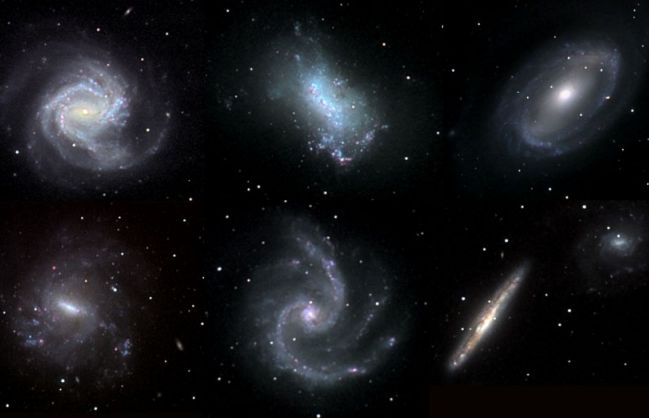
Visitors' Galaxy Gallery
Explanation: A tantalizing assortment of island universes is assembled here. From top left to bottom right are the lovely but distant galaxies M61, NGC 4449, NGC 4725, NGC 5068, NGC 5247, and NGC 5775/5774. Most are spiral galaxies more or less like our own Milky Way. The color images reveal distinct pink patches marking the glowing hydrogen gas clouds in star forming regions along the graceful spiral arms. While Virgo cluster galaxy M61 is perhaps the most striking of these spirals, the interesting galaxy pair NGC 5775/5774 neatly contrasts the characteristic spiral edge-on and face-on appearance. The one exception to this parade of photogenic spiral galaxies is the small and relatively close irregular galaxy NGC 4449 (top middle). Similar to the Large Magellanic Cloud, companion galaxy to the Milky Way, NGC 4449 also sports young blue star clusters and pink star forming regions. All the galaxies in this gallery were imaged with a small (16 inch diameter) reflecting telescope and digital camera by public participants in the Kitt Peak National Observatory Visitor Center's Advanced Observing Program.
Credit: Courtesy Adam Block (KPNO Visitor Program), NOAO, NSF -
Griffith Observatory
The Griffith Observatory is located in in Los Angeles, California, United States. Sitting atop a hill in L.A.'s Griffith Park, it commands an incredible view of downtown Los Angeles, Hollywood and all the way to the Pacific Ocean. The observatory is a favorite attraction for tourists and locals alike, and features an extensive array of space- and science-related displays.
Contemporary view of L.A. from behind the Griffith Observatory.
The observatory was featured in the climax of the James Dean film Rebel Without a Cause, and more recently appeared in the movies Bowfinger and Charlie's Angels: Full Throttle. One of its earliest roles was as the palace of Emperor Ming the Merciless in the late Flash Gordon movie serials of the 1930s.
In the Grand Theft Auto: San Andreas video game this landmark is featured and is identical to it in real life.
History
The land on which the observatory sits was donated to the City of Los Angeles by Col. Griffith J. Griffith in 1896. In his will, Griffith donated funds to build an observatory, exhibit hall, and planetarium on the donated land. Construction began on June 20, 1933 using a design developed by architect John C. Austin based on preliminary sketches by Russell W. Porter. The observatory and accompanying exhibits were officially opened on May 14, 1935. In its first five days of operation the observatory logged more than 13,000 visitors.
Vintage postcard view of the Observatory.
During World War II the planetarium was used to train pilots the skill of celestial navigation. The planetarium was again used for this purpose in the 1960s to train Apollo program astronauts for the first lunar missions.
The planetarium was renovated in 1964 and a Mark IV Zeiss projector was installed.
The observatory was closed in 2002 for renovation and expansion with a re-opening date of 14 May 2006. Among the renovations being done is the replacement of the Zeiss Mark IV with a Zeiss Mark IX Universarium star projector.
Exhibits
The first exhibit visitors encountered in 1935 was the Foucault pendulum, which was designed to demonstrate the rotation of the Earth. The exhibit also included a twelve-inch Zeiss telescope, a solar telescope, and a thirty-eight foot relief model of the moon's north polar region.
Col. Griffith requested that the observatory include a display on evolution which was accomplished with the Chosmochron exhibit which included a narration from Caltech Professor C. Stock and an accompanying slide show. The evolution exhibit existed from 1937 to the mid 1960s.
Also included in the original design was a planetarium. The first shows covered topics including the moon, worlds of the solar system, and eclipses.
Issue #117 -
Astronomy Picture of the Day
2005 June 19
Noctilucent Clouds
Explanation: Sometimes it's night on the ground but day in the air. As the Earth rotates to eclipse the Sun, sunset rises up from the ground. Therefore, at sunset on the ground, sunlight still shines on clouds above. Under usual circumstances, a pretty sunset might be visible, but unusual noctilucent clouds float so high up they can be seen well after dark. Pictured above, a network of noctilucent clouds casts a colorful but eerie glow visible above the dark. Although noctilucent clouds are thought to be composed of small ice-coated particles, much remains unknown about them. Recent evidence indicates that at least some noctilucent clouds result from freezing water exhaust from Space Shuttles.
Credit & Copyright: Pekka Parviainen (Polar Image) -
Issue #118